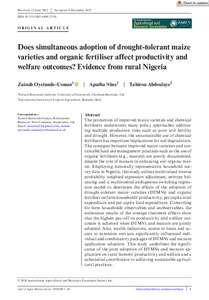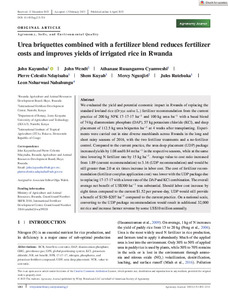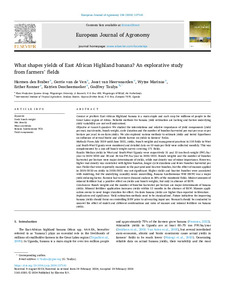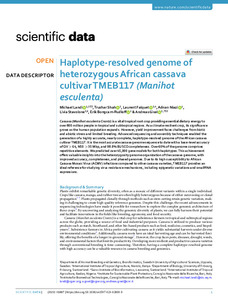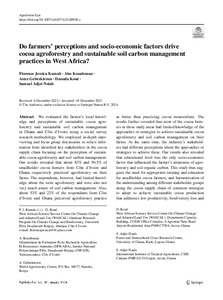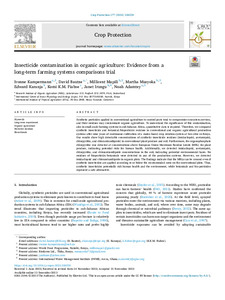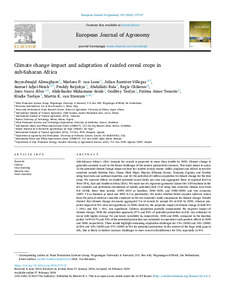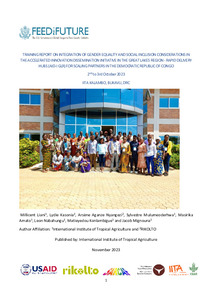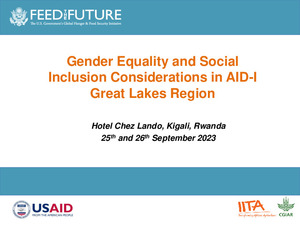Welcome to the International Institute of Tropical Agriculture Research Repository
IITA Bibliography System: Recent submissions
Now showing items 221-240 of 8094
-
Fertilizer-bioinsecticide synergy improves maize resilience to Spodoptera frugiperda infestation
(2024-03)Fall armyworm (FAW), Spodoptera frugiperda (Smith) (Lepidoptera: Noctuidae), invasion in Africa has threatened food security. Optimization of plant tolerance and post-infestation recovery are among the management tactics that are being promoted for the integrated management of this pest, but these techniques are poorly studied in sub-Saharan Africa. Our study examined the efficacy of enriched compost, split-NPK fertilization, conventional fertilization, and bioinsecticides on FAW infestation rates, ... -
Does simultaneous adoption of drought-tolerant maize varieties and organic fertiliser affect productivity and welfare outcomes? Evidence from rural Nigeria
(2024-01)The promotion of improved maize varieties and chemical fertilisers underscores many policy approaches addressing multiple production risks such as poor soil fertility and drought. However, the unsustainable use of chemical fertilisers has important implications for soil degradation. The synergies between improved maize varieties and sustainable land use management practices such as the use of organic fertilisers (e.g., manure) are poorly documented, despite the role of manure in enhancing soil ... -
Urea briquettes combined with a fertilizer blend reduces fertilizer costs and improves yields of irrigated rice in Rwanda
(2023-04-06)We evaluated the yield and potential economic impact in Rwanda of replacing the standard lowland rice (Oryza sativa L.) fertilizer recommendation from the current practice of 200 kg NPK 17-17-17 ha−1 and 100 kg urea ha−1 with a basal blend of 74 kg diammonium phosphate (DAP), 57 kg potassium chloride (KCl), and deep placement of 112.5 kg urea briquettes ha−1 at 4 weeks after transplanting. Experiments were carried out in nine diverse marshlands across Rwanda in the long and short rainy seasons of ... -
What shapes yields of East African Highland banana? An explorative study from farmers’ fields
(2024-05)Context or problem East African Highland banana is a main staple and cash crop for millions of people in the Great Lakes region of Africa. Reliable methods for banana yield estimation are lacking and factors underlying yield variability are not well understood. Objective or research question We studied the interrelations and relative importance of yield components (yield per mat, mat density, bunch weight, cycle duration and the number of bunches harvested per mat per year or per hectare per ... -
Haplotype-resolved genome of heterozygous African cassava cultivar TMEB117 (Manihot esculenta)
(2023-12-09)Cassava (Manihot esculenta Crantz) is a vital tropical root crop providing essential dietary energy to over 800 million people in tropical and subtropical regions. As a climate-resilient crop, its significance grows as the human population expands. However, yield improvement faces challenges from biotic and abiotic stress and limited breeding. Advanced sequencing and assembly techniques enabled the generation of a highly accurate, nearly complete, haplotype-resolved genome of the African cassava ... -
Datasets from fertilized improved and local varieties of cassava grown in the highlands of South Kivu, Democratic Republic of Congo
(2024-02)The use of mineral fertilizer and organic inputs with an improved and local variety of cassava allows (i) to identify nutrient limitations to cassava production, (ii) to investigate the effects of variety and combined application of mineral and organic inputs on cassava growth and yield and (iii) to evaluate the profitability of the improved variety and fertilizer use in cassava production. Data on growth, yield and yield components of an improved and local variety of cassava, economic analysis, ... -
Farm typology for digital green and fertilizer Ethiopia use cases
(International Institute of Tropical Agriculture, 2023) -
Enhancing smallholder maize shelling mechanization through the collective business model: the case of Northern Ghana.
(2024)This paper assessed the conditions contributing to the success of smallholder farmer groups in northern Ghana using mechanical maize shellers (MMS) based on a collective business model. A sample of 156 farmers from 18 intervention communities was analyzed using qualitative comparative analysis (QCA) to examine the conditions necessary to increase usage of MMS. The results revealed a single configuration for achieving high group MMS usage, observed in about 24 percent of the cases. This configuration ... -
Distribution and diversity of emergent Banana bunchy top virus infecting banana and plantain in Cameroon, Central Africa
(2024-03-05)Invasions of arthropod vectors and viruses are the main factors associated with emerging plant viral diseases. The presence of the Banana bunchy top virus (BBTV, genus Babuvirus), an aphid-transmitted virus responsible for the banana bunchy top disease (BBTD), was first confirmed in 2008 in the South region of Cameroon. This study reports on surveys over 14 years to determine the status of BBTV spread and virus diversity in Cameroon. A total of 544 fields extending through 81 districts in 7 regions ... -
Do farmers' perceptions and socio-economic factors drive cocoa agroforestry and sustainable soil carbon management practices in West Africa?
(2024-01-09)We evaluated the farmer’s local knowledge and perceptions of sustainable cocoa agroforestry and sustainable soil carbon management in Ghana and Côte d'Ivoire using a social survey research methodology. We employed in-depth interviewing and focus group discussions to solicit information from identified key stakeholders in the cocoa supply chain focusing on the perception of sustainable cocoa agroforestry and soil carbon management. Our results revealed that about 83% and 50.5% of smallholder cocoa ... -
Factors influencing gender and youth integration in agricultural research and innovation in Africa
(2024)Integrating gender and youth in Agricultural Research and Innovation (R & I) is important for strengthening the impact and inclusiveness of the research initiatives. The integration is more critical in Africa due to the prevalence of exclusive gender and age norms that undermine the place and role of women and youth in the food systems. The consideration of women and youth as ‘helpers’ instead of farmers aggravated inequalities in accessing and controlling over land and other resources, opportunities ... -
Insecticide contamination in organic agriculture: evidence from a long-term farming systems comparisons trial
(2024-03)Synthetic pesticides applied in conventional agriculture to control pests tend to compromise ecosystem services, and their residues may contaminate organic agriculture. To understand the significance of this contamination, also in small-scale farming systems in sub-Saharan Africa, quantitative data is required. Therefore, we compared synthetic insecticide and botanical/biopesticide residues in conventional and organic agricultural production systems after nine years of continuous cultivation of a ... -
Characterization of TPEs for cassava in Tanzania and banana in Ghana & Tanzania
(IInternational Institute of Tropical Agriculture, 2023) -
Global strategy for the conservation and use of Vigna
(Global Crop Diversity Trust, 2023) -
Climate change impact and adaptation of rainfed cereal crops in sub-Saharan Africa
(2024-02-24)Sub-Saharan Africa’s (SSA) demand for cereals is projected to more than double by 2050. Climate change is generally assumed to add to the future challenges of the needed productivity increase. This study aimed to assess (i) the potential climate change impact on four key rainfed cereals (maize, millet, sorghum and wheat) in ten SSA countries namely Burkina Faso, Ghana, Mali, Niger, Nigeria, Ethiopia, Kenya, Tanzania, Uganda, and Zambia using local data and national expertise, and (ii) the potential ... -
Designing dioscorea genomes for improved nutritional and pharmaceutical properties
(Springer, 2023-12-15)Dioscorea species, commonly known as “Yams,” belong to family Dioscoreaceae consisting of about 600 species distributed from Africa, Asia, the Caribbean’s South America, and the South Pacific islands. The tuber of this genus is well known for their organoleptic properties, making them the most widely used food for carbohydrate, dietary supplements, and famine food. West Africa represents the region where yams are mostly consumed because of their underground and/or aerial tubers representing valuable ... -
Cocoa under heat and drought stress
(Springer, 2023)Cocoa (Theobroma cacao L.) is an important cash crop in many tropical countries, particularly in West Africa. Heat and drought are both known to affect the physiology of cocoa plants through reduced rates of photosynthesis and transpiration, as well as changed physiological processes such as the functions of photosystems, chlorophyll synthesis, stomatal conductance and expression of heat-shock proteins. This in turn leads to decreased yields and increased risks of mortality under severe heat and ... -
Segmental duplications drive the evolution of accessory regions in a major crop pathogen
(2024)Many pathogens evolved compartmentalized genomes with conserved core and variable accessory regions (ARs) that carry effector genes mediating virulence. The fungal plant pathogen Fusarium oxysporum has such ARs, often spanning entire chromosomes. The presence of specific ARs influences the host range, and horizontal transfer of ARs can modify the pathogenicity of the receiving strain. However, how these ARs evolve in strains that infect the same host remains largely unknown. We defined the ... -
Training report on integration of gender equality and social inclusion considerations in the accelerated innovation dissemination initiative in the Great Lakes region - rapid delivery hubs (AID-I GLR) for scaling partners in the Democratic Republic of Congo
(International Institute of Tropical Agriculture, 2024)A two-day training course on Gender Equality and Social Inclusion (GESI) Considerations in the Great Lakes Accelerated Innovation Delivery Initiative Delivery Hub (AID-I GLR) project was held from 2nd to 3rd October 2023 at IITA's Kalambo Research Station in South Kivu Province, Democratic Republic of Congo (DRC). The training was organized by IITA AID-I GLR team under guidance of Dr. Millicent Liani (IITA), the project’s GESI technical lead, with the support of Mrs Lydie KASONIA (GESI focal person ... -
Feed the Future: Gender equality and social inclusion considerations in AID-I Great Lakes Region
(United States Agency for International Development, 2023)


